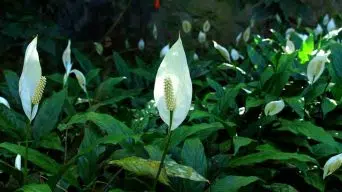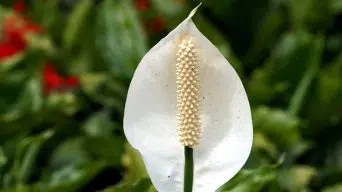Are your Peace Lily leaves turning black? Don’t worry; you’re not alone.
Many peace lily owners have to deal with this issue at some point. And it’s not always easy to figure out what’s causing it.
While there are several potential causes, there is no need to panic.
In most cases, the problem is easily remedied.
Why Are My Peace Lily Leaves Turning Black and How Can I Fix It?
Peace Lily plants are beautiful, easy to care for and make excellent houseplants.
They are known for their white flowers that bloom throughout the year.
But what happens when the leaves start to turn black?
Here are 10 possible reasons why your Peace Lily leaves turn black and what you can do about it.
1. Too Much Water
The most common reason for Peace Lily leaves to turn black is too much water.
Peace Lilies are native to tropical rainforests and are used to growing in humid conditions.
But when they are grown as indoor plants, they can often be overwatered.
Overwatering usually occurs when the Peace Lily plant is watered too often, or the pot doesn’t have adequate drainage, causing the roots to sit in water.
If the Peace Lily is overwatered, the roots cannot get the oxygen they need and begin to rot.
This can cause black leaves and eventually kill the plant.
Other symptoms of overwatering include wilting, yellow leaves, and stunted growth.
How To Fix It
If you have an overwatered Peace Lily, the best thing to do is to stop watering it for a while and let the soil dry out.
You can also try to remove the plant from its pot and check the roots.
If they are black or mushy, they are probably rotting and need to be removed.
Once you’ve removed the rotting roots, replant the Peace Lily in fresh soil and water it only when the soil is dry to the touch.
2. Too Much Sunlight
Another common reason for Peace Lily leaves turning black is too much sunlight.
Peace Lilies are used to growing in shady conditions and don’t do well in direct sunlight.
They thrive in bright indirect light but can be damaged by too much direct sunlight, especially if the leaves are exposed to it for extended periods.
If the leaves are exposed to too much direct sunlight, they can get sunburned and turn black.
You can also tell if the leaves are sunburned if they have brown patches or spots.
How To Fix It
If your Peace Lily is getting too much sunlight, the best thing to do is to move it to a shadier spot.
Place it in an east- or north-facing window where it will get bright indirect light but won’t be exposed to direct sunlight.
You can also try to cover the plant with a sheer curtain or blind to filter the sunlight.
If they are already sunburned, the leaves will not recover and need to be removed.
3. Too Much Fertilizer
Another common reason for Peace Lily turning black is too much fertilizer.
Peace Lilies are light feeders and don’t need much fertilizer to grow well.
Too much fertilizer can be harmful to the plant.
When Peace Lilies are fertilized too often or with too much fertilizer, the roots can be burned.
This can cause the Peace Lily leaves to turn brown, black, or yellow.
Other symptoms of fertilizer burn include wilting, stunted growth, and leaf drop.
How To Fix It
If you think your Peace Lily has been fertilized too much, the best thing to do is stop fertilizing it for a while.
You can also flush the potting soil with water to remove any excess fertilizer.
Only fertilize your Peace Lily when it is actively growing, typically in spring and summer, and use a half-strength solution.
4. Temperature Stress
Another potential reason for Peace Lily turning black is temperature stress.
Peace Lilies are native to tropical rainforests and prefer warm, humid conditions.
They can tolerate some temperature fluctuation but can be damaged by extreme cold or heat.
If the leaves of the plant are exposed to temperatures that are too cold or too hot, they can turn black.
You can tell if the leaves turn black from temperature stress if they are wilted or dried out.
If the leaves are exposed to too cold temperatures, they will have black and brown tips.
If the leaves are exposed to too hot temperatures, they will turn black and dry out.
How To Fix It
If you think your Peace Lily is experiencing temperature stress, the best thing to do is move it to a spot where the temperature is more consistent.
Bring the plant inside if it is outside. If the plant is indoors, move it to a spot where it will not be in direct sunlight or near any heat sources.
5. Mineral Buildup
Another potential reason Peace Lily leaves turning black is a mineral buildup in the potting mix.
Over time, minerals in tap water can build up in the potting mix and become toxic to the plant.
This usually happens when the plant is watered with hard water or water that has high mineral content.
The most common symptoms of a mineral buildup are black or brown spots on the leaves.
Other symptoms include yellowing leaves, wilting, and stunted growth.
How To Fix It
If you think your Peace Lily has a mineral buildup, the best thing to do is to repot it in a fresh potting mix.
You can also try watering it with distilled water or rainwater to flush the minerals out of the potting mix.
Use bottled water or water that has been filtered to remove minerals if you can’t find distilled or rainwater.
6. Pest Infestation
Another possible reason Peace Lily’s leaves turn black is a pest infestation.
Peace Lilies are susceptible to various pests, including aphids, mealybugs, spider mites, and thrips.
Aphids, mealybugs, and spider mites are all sap-sucking pests that can cause black leaves.
They can also cause the Peace Lily leaves to curl, yellow, or wilt.
Thrips are tiny winged insects that feed on the cells of the plant.
Peace Lily leaves may exhibit discoloration, appearing yellow, black, or brown, due to their influence.
They can also cause the leaves to become distorted or to have white spots.
How To Fix It
If you think your Peace Lily has a pest infestation, the best thing to do is to isolate the plant from other plants.
This will prevent the pests from spreading.
You can remove the pests from the plant with a cotton swab dipped in rubbing alcohol.
You can also use insecticidal soap or neem oil to control the infestation.
This is an excellent option for those who want to avoid using chemical pesticides.
7. Fungal Diseases
Peace Lilies are susceptible to various fungal diseases, including anthracnose, black spot, and sooty mold.
Anthracnose (Leaf Spots)
Anthracnose is characterized by dark brown or black spots on the leaves, which can eventually lead to leaf drop.
The fungus grows in cool, wet conditions, so it’s essential to water your plant only when the soil is dry and keep the leaves dry.
Black Spot
Black spot is another fungal disease that affects Peace Lilies.
It’s characterized by black spots on the leaves, which can eventually lead to leaf drop.
The fungus grows in warm, humid conditions, so it’s essential to water your plant only when the soil is dry and keep the leaves dry.
Sooty Mold
Sooty mold is a black fungus that grows on the leaves of Peace Lilies. It’s not harmful to the plant, but it can be unsightly.
The fungus grows in warm, humid conditions, so it’s important to water your plant only when the soil is dry and keep the leaves dry.
How To Fix It
If you think your Peace Lily has a fungal disease, the best thing to do is to isolate the plant from other plants.
This will prevent the fungus from spreading.
You can also remove the affected leaves and dispose of them.
It’s important to sterilize your pruning tools before and after use to prevent the spread of the disease.
You can use a fungicide to treat the plant, but following the directions on the label is essential.
8. Bacterial Diseases
Peace Lilies are susceptible to various bacterial diseases, including bacterial leaf spot and bacterial blight.
Bacterial Leaf Spot
Bacterial leaf spot is characterized by small, dark spots on the leaves, which can eventually lead to leaf drop.
The bacteria grow in cool, wet conditions, so it’s important to water your plant only when the soil is dry and keep the leaves dry.
Bacterial Blight
Bacterial blight is characterized by small, dark spots with yellow halos on the leaves, which can eventually lead to leaf drop.
The bacteria grow in warm, humid conditions, so it’s important to water your plant only when the soil is dry and keep the leaves dry.
How To Fix It
If you think your Peace Lily has a bacterial disease, remove any affected leaves and destroy them.
It’s important to sterilize your pruning tools before and after use to prevent the spread of the disease.
You can also try treating the plant with a bacterial fungicide, but follow the instructions on the label carefully.
9. Root Rot
Root rot is a severe problem that can affect Peace Lilies. It’s caused by a variety of fungi, including Pythium and Phytophthora.
These fungi attack the roots of the plant, causing them to rot. The plant will eventually die if the root rot is not treated.
Root rot is often caused by overwatering, so it’s essential to water your plant only when the soil is dry.
How To Fix It
If you think your Peace Lily has root rot, the best thing to do is remove the plant from the pot and inspect the roots.
If the roots are black or mushy, they are probably rotted.
The best thing to do is cut off the rotted roots and replant the plant in a fresh potting mix.
It’s important to sterilize your pruning tools before and after use to prevent the spread of the disease.
10. Physical Damage
Peace Lilies are delicate plants that can be easily damaged by physical trauma.
This can happen if the plant is dropped or if it’s hit by something.
When this happens, the damaged tissue will die, and the leaves will turn black.
How To Fix It
If you think your Peace Lily has been damaged, you should first examine the plant carefully.
Look for any signs of bruising or injury on the leaves.
If you find any, carefully remove the damaged leaves and dispose of them.
Once you’ve done that, water the plant as usual, and it should recover in time.
How To Prevent Black Spots On Peace Lily Leaves
Preventing black spots on Peace Lily leaves is best done by providing the plant with the necessary care.
Here are some tips to help you keep your Peace Lily healthy and free of black spots:
- Peace Lilies prefer indirect sunlight. If the leaves are getting too much sun, they will start to turn yellow and then brown or black.
- Water your Peace Lily when the top inch of soil is dry. Overwatering can lead to fungal growth and leaf spots.
- Use a well-draining potting mix. Peace Lilies don’t like to sit in wet soil.
- Fertilize your Peace Lily every two weeks during the growing season. Use a balanced fertilizer diluted to half strength.
- Remove any yellow or brown leaves as soon as you see them. These leaves are no longer able to photosynthesize and will only drain energy from the rest of the plant.
- Avoid getting water on the leaves of your Peace Lily. Water on the leaves can lead to fungal growth and leaf spots.
- Keep an eye out for pests. Aphids, mealybugs, and spider mites can all cause leaf spots. Treat any infestations promptly.
- Keep the leaves of your Peace Lily clean by dusting them with a soft cloth or brushing them with a soft brush.
Final Thoughts
When it comes to Peace Lily leaves turning black, there can be several reasons.
The most common are fungal diseases, overwatering, or sunburn.
Fortunately, most of these problems can be easily fixed with little care.
By identifying the problem and taking the appropriate action, you can keep your Peace Lily healthy and free of black spots.







